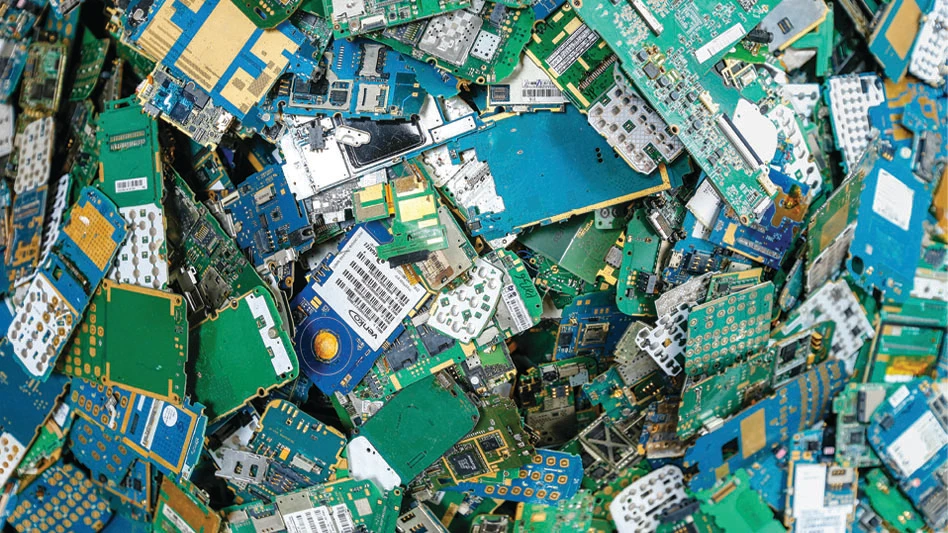Construction and demolition debris recycling is a fast-growing market in the United States, and many recyclers of other commodities are wondering what the opportunities are like in this area.
|
Typical Construction Debris Estimated For A 2,000-Square-Foot Home |
|
MATERIAL WEIGHT VOLUME (in pounds) (in cubic yards)* Solid Sawed Wood 1,600 6 Engineered Wood 1,400 5 Drywall 2,000 5 Cardboard (OCC) 600 20 Metals 150 1 Vinyl (PVC) 150 1 Masonry** 1,000 1 Containers – paints, caulks, etc. 50 – Other 1,050 11 Total 8,000 50 * Volumes are highly variable due to compressibility and captured air space in waste materials. **Siding material assumes three sides vinyl siding and brick veneer on home’s front facade. Source: NAHB Research Center |
The first step is to decide what aspect to pursue: collecting demolition debris; collecting construction debris; or processing demolition or construction debris. The split between C&D materials is quite distinct when it comes to the materials handled and the types of equipment required for the job. Within each area, there is opportunity to specialize in certain materials. Conigliaro Industries, Framingham, Mass., for example, has carved a market niche by specializing in polystyrene and vinyl materials in addition to other C&D recyclables.
No matter how you slice it, C&D is big business. But just because you are running an aluminum or paper recycling operation today does not mean you can be successful in C&D. "There’s a 100 percent difference in the materials," says Bob Brickner, senior vice president of GBB, Falls Church, Va. "The cast of characters moving the materials is different; the transportation requirements are totally different; and the competitors are different."
Outside of being in business as an entrepreneur and knowing that it takes hard work to do the job, there is little cross-over. In fact, Brickner indicates that a person with experience in general contracting or construction may be better positioned to start a C&D recycling operation than a recycler. At least that individual would be familiar with the players, the types of material generated, and the market.
But there are some steps to follow for recyclers interested in the industry.
"I’d recommend that anyone who wants to get started in this business take a rolloff container full of C&D debris and go through it to get a proper understanding of the percentages of each material," says Tom Roberts, vice president of Atlas Environmental, Inc., Plantation, Fla., and president of the Florida C&D Recyclers Coalition.
Then, says Roberts, take each material and draw an itemized flow chart for the handling costs and markets available. Weigh those numbers versus basics like tip fees and market share, and see if you can make a buck. In an area that supports a $12 per cubic yard tip fee, an operation can afford better equipment. If the going fee is $5 a yard, the operation will have to make it up some other way.
Roberts says it is important to have experience handling large, heavy bulky materials. A ferrous scrap recycler, therefore, might have an edge here.
Ted Ondrick Construction, Chicopee, Mass., operates portable C&D processing equipment. However, when the company got into the business – 17 years ago, doing a job at Westover Air Force Base – there were no materials specifications and no guidelines. Most of the company’s early work was with private landowners or parking lot contractors. Later, the state became interested in recycling, and then some towns got on the bandwagon. Today, Ondrick is a regional leader in a business based on state specifications, including M11-1. "We were crazy when we got started," says Ondrick’s Paul Mullen. "But now that it is approved, it was a brilliant idea."
Regional factors play an important role. For example, most successful C&D recyclers are located in areas where tipping fees for disposing of materials are high, says Brickner. While there is no exact figure on the tonnage of C&D material processed each year, he estimates 100 million tons of C&D debris are landfilled or recycled annually.
Tipping fees are the market push, agrees Peter Yost, project manager in the structures and environmental systems division of the National Association of Home Builders Research Center, Upper Marlboro, Md. But demand is the market pull. The association conducted a study comparing Baltimore and Grand Rapids, Mich. Both areas have a $30 a ton tip fee. But in Michigan, the fee for clean, separated wood was $2 per cubic yard; in Maryland it was $4, the same as the $30 per ton tip fee. Why? In Michigan, Yost notes, there was a wood-fired generation plant less than 90 miles away, providing a good, steady demand for wood.
At an operation like ERRCO Corp., Epping, N.H., the demand is stronger for demolition material than for construction debris.
"It is more difficult to separate the plastic, paper, caulking tubes and old lunch containers from construction," says Jonathan Hixon, vice president of ERRCO. That material has to be landfilled. In contrast, demolition is 80 percent wood and the rest of the material is relatively clean.
ERRCO deals mainly with contractors and haulers. The plant is set up to take mixed C&D material, including shingles, wood, sheet rock, windows, all metals and hardware. The firm does not handle rugs, furniture, or other inside materials, but it does take separated loads of shingle, concrete and asphalt or wood at a reduced tipping fee. A typical tip fee for the area would be $65 per ton. ERRCO gets $40 to $60 per ton for mixed demolition material.
Ondrick Construction, on the other hand, deals in the ABCs – asphalt, brick and concrete. "If you are getting into any of the ABCs, you have to handle all three," Mullen says.
DISTINCT MATERIALS
Again, although they are lumped together in most discussions, construction debris and demolition debris are quite different in content and should be approached as separate businesses. The materials are often disposed of in the same place, but recovery and marketing of the materials is not the same.
"About 99.99 percent of demolition debris can be recycled without any problem," says Michael Taylor, executive director of the National Association of Demolition Contractors, Doyle-stown, Pa. "But construction debris has mastics (protective coatings), caulks and tars that have greater potential for coming under Resource Conservation and Recovery Act coverage."
On the other hand, the majority of debris disposed at demolition landfills is relatively inert. "These materials are not a source of significant environmental risk," says Taylor.
Brickner, however, points out that new construction or remodeling debris generally is a known commodity, whereas a firm tearing down old buildings may encounter walls that contain lead paint or asbestos. For this reason, a vital first step for demolition projects includes a walk-through visual inspection to identify items that will require special handling or testing.
Both agree that there are major differences in the makeup of construction and of demolition debris. Demolition material generally is developed from a tear-down operation and the recycler must deal with what is there. Usually a bidder will have a much better idea of what is going to be recycled in new construction. The fractions of materials differ, too. Perhaps 99 percent of the cinder block in a demolition job is recyclable. However, less than one-half percent of the cinder block in new construction is broken or wasted and therefore recycled. Demolition debris requires lots of heavy equipment and large trucks for transportation.
On a demolition site, floor coverings, ceiling material and interior walls must be removed before structural demolition takes place. Yost says wood, drywall and cardboard make up the majority of new residential construction debris. New construction debris goes into a roll-off box and is relatively easy to cart off, and there is a market opportunity there for recycling.
Since new construction debris is generated at discrete times, it is usually source-separated at disposal. Yost says there is a big opportunity for recycling-cleanup services, billed by the square foot of construction. Builders like being able to subcontract the service out and, charging by the foot, have a handle on their costs. Fees range from 30 cents to $1.25, Yost says, depending on the degree of service. NAHB figures show the typical builder pays $511 per house for debris disposal.
Keeping those 30-yard boxes off the job site eliminates another pollution problem for builders, since as much as 25 percent of the material in a new construction site dump box is made up of foreign items such as broken furniture, tires, and other material dumped by outsiders. Yost recommends recyclers set aside a small area with a mesh fence and pick up debris regularly.
MARKET ENTRY
One area of opportunity in the C&D recycling market is in concrete recycling. A typical job is taking concrete out of old highways being repaved. Most of the recyclable material gets processed on the spot, going back as crushed aggregate for the new roadbed.
In Southern California, Florida and much of the Southeast, concrete recycling is a big business with a big future. Since the areas are aggregate-poor, they are hot markets for material that can be used as base for paving projects.
Natural disasters have been a major source of concrete demolition material. Disasters often provide a time for newcomers to get into the business since there is a lot of business to go around.
Wood is not as easy a market as it would appear. By weight, wood is the largest fraction of debris from new home construction. The material is sometimes processed for sludge drying operations and for particle board. But the product coming in can vary from job to job, and without steady quality and consistency of product, marketing is tough. One firm that went into the wood processing business producing landscaping chips for consumers, found itself stuck with expensive equipment in a losing proposition, since it had no enduring markets.
Roberts says there are three levels of entry to the market. The first is to go with a low-technology C&D materials recovery facility, using a lot of physical labor and hand sorters, and skid-steer loaders to move materials around. The second is a medium-tech operation with some sorting conveyors and screens, perhaps chipping equipment or a wood grinder. A high-tech outfit will have a series of shaker or vibrator screens to clean materials, air rectifiers to pull out papers and plastics, and magnets for metals. An operation handling 1,000 cubic yards a day will need more than $1 million in capital to get started, Roberts says. He also warns newcomers to have ready markets for the materials.
But markets for C&D debris are not yet steady enough to warrant treating the materials like commodities, warns Greg Conigliaro, president of Conigliaro Industries.
"We don’t care what the prices are or will be in the market for our end material, because we don’t play the commodities game," he says. "We work backward. First, we determine our handling costs, then the transportation costs, then the processing costs, then we look at what the price is that day for the material. Then we quote a price, and it is only good for one week. We make sure every run is profitable."
Transportation and trucking are make-or-break factors in bidding jobs in C&D debris recycling, since the materials tend to be heavy and bulky to begin with.
Another factor to consider is the size of the yard at your plant. It may sound trivial, but it is actually important to make sure your facility is large enough to handle the volume you’ll be processing. Taylor also warns that, under some state regulations, a yard handling C&D materials may be considered a transfer station and be subject to additional regulation.
One pearl of wisdom shared by almost every C&D contractor interviewed for this article is that ‘the right guy can make a living in C&D recycling...but not in my city.’" Actually, that philosophy makes some sense both for the established operator and the newcomer. Some areas – like Philadelphia, Cleveland, Chicago and Southern California – have entrenched C&D recycling firms with long-term clients. The only way to break into the market would be to cut prices drastically, and most of those operations are working on razor-thin margins already.
Opportunity is being realized in areas like northern New Jersey where several C&D firms handle the material from New Jersey and New York City.
Also, Fundamental Action to Conserve Energy, an organization in Fitchburg, Mass., in the course of its C&D Material Infrastructure Development Project, has identified two areas of Massachusetts ripe for C&D handling. Since the data was published, it appears that Springfield will get a transfer station with a 500-ton-per-day capacity. However, nothing yet has happened in Worcester, the other target site. State and federal environmental resource departments; rural development committees; and contractor, recycling and remodeling groups are all good places to hitch up to potential market opportunities.
RESIDENTIAL MARKET
Waste management costs on a residential job site range from 1 percent to 2 percent of the total cost of a project. It’s a sizable enough amount that builders must consider disposal when figuring their building costs, Yost says. Since residential builders are not making a lot of money right now, with profits ranging between 3 percent and 5 percent, they are looking everywhere to save money.
An average new home building project generates about four tons of debris, according to Yost. That includes two tons of wood debris, a ton of drywall, 1,000 pounds of masonry, 600 pounds of cardboard, 150 pounds vinyl and 150 pounds of metals.
He says he expects the cardboard fraction to increase dramatically as more and more of the houses are prefabricated or prefinished at a factory and then delivered to the site.
Brickner notes that specifications are currently being developed in many areas of C&D debris handling. Those who were recycling in the early days know about the challenges of developing specifications and building a market. Latecomers were, in effect, handed market specifications.
That reflects Mullen’s point about markets opening up once the groundwork is laid. Ondrick, which can handle 350 to 400 tons per hour, says the secret is to look at a job and see what can be made of the debris and where it can be used beneficially on-site. "Anyone can crush," Mullen says. "The challenge is making something extra – perhaps fill for a parking lot – out of the material."
There is money to be made by those who investigate markets. As Brickner concludes, "If you’ve been through the school of hard knocks before, why would you want to do it again?"
The author is an environmental writer based in Strongsville, Ohio.
Sidebar
Touch All Bases When Getting Started
There are several bases a newcomer to construction and demolition debris recycling must touch before getting started in business, according to Tom Roberts, vice president of Atlas Environmental Inc., Plantation, Fla.
First, know your market share, and realize that C&D debris recycling is a regional business. In Southern Florida, for instance, a site 40 miles away may not effect your business.
Know your local tip fees. If the gate rate is $4 a yard in your area, a C&D debris recycling operation will be marginal. If there is a C&D landfill 100 miles away charging $2 a yard, it will pay to take a 60- or 80-yard truck to the other location. If a Class I landfill is charging $50 a ton, you will not be able to charge much more than $25, depending on location.
There are four reasons why someone will use a particular location: price, proximity to job site, turnaround time, and less damage to tires (since most C&D recycling yards are on concrete pads).
Be sure there is a large population base nearby. C&D debris recycling prospers where there are people.
Know the building industry and its rate of growth over the past 10 years. Is it growing locally? Remember that 60 percent to 80 percent of your material will come from the building industry.
Understand state regulations first. Then look at county and municipal rules. Dade County, Fla., forbids wood in landfills, for instance. It must be ground up or used in co-generation.
Next, know what your cost will be to capitalize a C&D debris recycling operation. Roberts puts the cost of a good 1,000-cubic-yard-per-day operation at about $1 million. Add in fuel, maintenance, transportation and costs to dispose of residues.
Finally, ensure end markets – have an outlet for everything that comes onto the site. "If you can’t close the loop, it will be difficult to make it in C&D debris recycling," Roberts warns.

Explore the November 1996 Issue
Check out more from this issue and find your next story to read.
Latest from Recycling Today
- Haber raises $44M to expand to North America
- Canada Plastics Pact releases 2023-24 Impact Report
- Reconomy brands receive platinum ratings from EcoVadis
- Sortera Technologies ‘owning and operating’ aluminum sorting solutions
- IDTechEx sees electric-powered construction equipment growth
- Global steel output recedes in November
- Fitch Ratings sees reasons for steel optimism in 2025
- P+PB adds new board members





